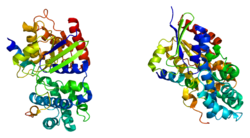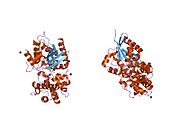RGS14
| edit |
| Regulator G-proteinske signalizacije 14 | |||||||||||
|---|---|---|---|---|---|---|---|---|---|---|---|
 PDB prikaz baziran na 1kjy. | |||||||||||
| Dostupne strukture | |||||||||||
| 1kjy, 2jnu | |||||||||||
| Identifikatori | |||||||||||
| Simboli | RGS14; | ||||||||||
| Vanjski ID | OMIM: 602513 MGI: 1859709 HomoloGene: 4735 GeneCards: RGS14 Gene | ||||||||||
| |||||||||||
| Pregled RNK izražavanja | |||||||||||
 | |||||||||||
 | |||||||||||
 | |||||||||||
| podaci | |||||||||||
| Ortolozi | |||||||||||
| Vrsta | Čovek | Miš | |||||||||
| Entrez | 10636 | 51791 | |||||||||
| Ensembl | ENSG00000169220 | ENSMUSG00000052087 | |||||||||
| UniProt | O43566 | Q8K2R4 | |||||||||
| RefSeq (mRNA) | NM_006480 | XM_001004354 | |||||||||
| RefSeq (protein) | NP_006471 | XP_001004354 | |||||||||
| Lokacija (UCSC) | Chr 5: 176.72 - 176.73 Mb | Chr 13: 55.38 - 55.39 Mb | |||||||||
| PubMed pretraga | [1] | [2] | |||||||||
Regulator G proteinske signalizacije 14 (RGS14) je protein koji kod ljudi reguliše G proteinsku signalizaciju. On je kodiran RGS14 genom.[1]
Funkcija
RGS14 je član familije regulatora G proteinske signalizacije. Ovaj protein sadrži jedan RGS domen, dva Raf-slična Ras-vezujuća domena (RBD), i jedan GoLoco motiv. On prigušuje signalnu aktivnost G-proteina. RGS14 se vezuje svojim GoLoco domenom, za specifične tipove aktiviranih GTP-vezanih G alfa podjedinica. Delujući kao GTPaza i aktivirajući protein (GAP), on povećava brzinu GTP konverzije u GDP. Ova hidroliza omogućava G alfa podjedinicama da se vežu za G beta/gama podjedinicu heterodimera, formirajući neaktivne G-proteinske heterotrimere, čime se zaustavlja signal. Alternativne transkriptne splajsne varijante ovog gena su poznate, ali su nedovoljno karakterisane.[1]
Povišeno izražavanje RGS14 proteina u V2 sekundarnom vizuelnom korteksu miševa promoviše konverziju kratkotrajne u dugotrajnu memoriju prepoznavanja objekata.[2] RGS14 je prirodni supresor sinaptičke plastičnosti CA2 neurona i na hipokampusu baziranog učenja i memorije.[3]
Interakcije
Za RGS14 je pokazano interaguje sa:
Reference
- ↑ 1,0 1,1 „Entrez Gene: RGS14 regulator of G-protein signalling 14”.
- ↑ López-Aranda MF, López-Téllez JF, Navarro-Lobato I, Masmudi-Martín M, Gutiérrez A, Khan ZU (July 2009). „Role of layer 6 of V2 visual cortex in object-recognition memory”. Science 325 (5936): 87–9. DOI:10.1126/science.1170869. PMID 19574389. Lay summary – Mad Science.
- ↑ Lee SE, Simons SB, Heldt SA, Zhao M, Schroeder JP, Vellano CP, Cowan DP, Ramineni S, Yates CK, Feng Y, Smith Y, Sweatt JD, Weinshenker D, Ressler KJ, Dudek SM, Hepler JR (September 2010). „RGS14 is a natural suppressor of both synaptic plasticity in CA2 neurons and hippocampal-based learning and memory”. Proc Natl Acad Sci U S A. DOI:10.1073/pnas.1005362107. PMID 20837545. Lay summary – MedicalDaily.
- ↑ 4,0 4,1 Kimple RJ, De Vries L, Tronchère H, Behe CI, Morris RA, Gist Farquhar M, Siderovski DP (August 2001). „RGS12 and RGS14 GoLoco motifs are G alpha(i) interaction sites with guanine nucleotide dissociation inhibitor Activity”. J. Biol. Chem. 276 (31): 29275–81. DOI:10.1074/jbc.M103208200. PMID 11387333.
- ↑ Hollinger S, Taylor JB, Goldman EH, Hepler JR (December 2001). „RGS14 is a bifunctional regulator of Galphai/o activity that exists in multiple populations in brain”. J. Neurochem. 79 (5): 941–9. DOI:10.1046/j.1471-4159.2001.00629.x. PMID 11739605.
- ↑ Kimple RJ, Kimple ME, Betts L, Sondek J, Siderovski DP (April 2002). „Structural determinants for GoLoco-induced inhibition of nucleotide release by Galpha subunits”. Nature 416 (6883): 878–81. DOI:10.1038/416878a. PMID 11976690.
- ↑ Shu FJ, Ramineni S, Amyot W, Hepler JR (January 2007). „Selective interactions between Gi alpha1 and Gi alpha3 and the GoLoco/GPR domain of RGS14 influence its dynamic subcellular localization”. Cell. Signal. 19 (1): 163–76. DOI:10.1016/j.cellsig.2006.06.002. PMID 16870394.
Literatura
- Snow BE, Antonio L, Suggs S, et al. (1997). „Molecular cloning and expression analysis of rat Rgs12 and Rgs14.”. Biochem. Biophys. Res. Commun. 233 (3): 770–7. DOI:10.1006/bbrc.1997.6537. PMID 9168931.
- Traver S, Bidot C, Spassky N, et al. (2001). „RGS14 is a novel Rap effector that preferentially regulates the GTPase activity of galphao.”. Biochem. J. 350 Pt 1: 19–29. PMC 1221220. PMID 10926822.
- Cho H, Kozasa T, Takekoshi K, et al. (2000). „RGS14, a GTPase-activating protein for Gialpha, attenuates Gialpha- and G13alpha-mediated signaling pathways.”. Mol. Pharmacol. 58 (3): 569–76. PMID 10953050.
- Hollinger, S, Taylor, JB, Goldman, EH, Hepler, JR (2001). „RGS14 is a bifunctional regulator of Gi/oalpha activity that exists in multiple populations in brain.”. Journal of Neurochemistry. 79 (5): 941–49. DOI:10.1046/j.1471-4159.2001.00629.x. PMID 11739605.
- Kimple RJ, De Vries L, Tronchère H, et al. (2001). „RGS12 and RGS14 GoLoco motifs are G alpha(i) interaction sites with guanine nucleotide dissociation inhibitor Activity.”. J. Biol. Chem. 276 (31): 29275–81. DOI:10.1074/jbc.M103208200. PMID 11387333.
- Sierra DA, Gilbert DJ, Householder D, et al. (2002). „Evolution of the regulators of G-protein signaling multigene family in mouse and human.”. Genomics 79 (2): 177–85. DOI:10.1006/geno.2002.6693. PMID 11829488.
- Kimple RJ, Kimple ME, Betts L, et al. (2002). „Structural determinants for GoLoco-induced inhibition of nucleotide release by Galpha subunits.”. Nature 416 (6883): 878–81. DOI:10.1038/416878a. PMID 11976690.
- Strausberg RL, Feingold EA, Grouse LH, et al. (2003). „Generation and initial analysis of more than 15,000 full-length human and mouse cDNA sequences.”. Proc. Natl. Acad. Sci. U.S.A. 99 (26): 16899–903. DOI:10.1073/pnas.242603899. PMC 139241. PMID 12477932.
- Hollinger S, Ramineni S, Hepler JR (2003). „Phosphorylation of RGS14 by protein kinase A potentiates its activity toward G alpha i.”. Biochemistry 42 (3): 811–9. DOI:10.1021/bi026664y. PMID 12534294.
- Ota T, Suzuki Y, Nishikawa T, et al. (2004). „Complete sequencing and characterization of 21,243 full-length human cDNAs.”. Nat. Genet. 36 (1): 40–5. DOI:10.1038/ng1285. PMID 14702039.
- Gerhard DS, Wagner L, Feingold EA, et al. (2004). „The status, quality, and expansion of the NIH full-length cDNA project: the Mammalian Gene Collection (MGC).”. Genome Res. 14 (10B): 2121–7. DOI:10.1101/gr.2596504. PMC 528928. PMID 15489334.
- Martin-McCaffrey L, Willard FS, Oliveira-dos-Santos AJ, et al. (2004). „RGS14 is a mitotic spindle protein essential from the first division of the mammalian zygote.”. Dev. Cell 7 (5): 763–9. DOI:10.1016/j.devcel.2004.10.004. PMID 15525537.
- Martin-McCaffrey L, Willard FS, Pajak A, et al. (2006). „RGS14 is a microtubule-associated protein.”. Cell Cycle 4 (7): 953–60. PMID 15917656.
- Rual JF, Venkatesan K, Hao T, et al. (2005). „Towards a proteome-scale map of the human protein-protein interaction network.”. Nature 437 (7062): 1173–8. DOI:10.1038/nature04209. PMID 16189514.
- Shu, FJ, Ramineni,S, Amyot, W, Hepler, JR (2007). „Selective interactions between Gialpha1 and Gialpha3 and the GoLoco/GPR domain of RGS14 influence its dynamic subcellular localization.”. Cellular Signalling. 19 (1): 941–49. DOI:10.1016/j.cellsig.2006.06.002. PMID 16870394.
- Shu, FJ, Ramineni,S, Hepler, JR (2009). „RGS14 is multifunctional scaffold that integrates G protein and Ras/Raf MAPkinase signaling pathways.”. Cellular Signalling.: in press.
- p
- r
- u
Monomerni | |
|---|---|
Heterotrimeni |










